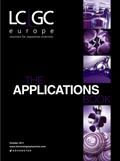Confirming Multi-Target Screening Full Scan Workflows of Pesticides in Food
Bruker Application Note
Introduction
Mass spectrometry enables fast and comprehensive full scan screening of hundreds of pesticide targets while also taking advantage of evaluation of unknowns and retrospective analysis. However, unambiguous identification of low level targets might be challenging in highly complex food extracts. Here, additional information is required — either by unselective MS-MS data by broad band CID (bbCID) or by selective, data-dependent MS-MS analysis confirming tentative findings. A recent study describes fast and quantitative workflows with these confirmation strategies.
Experimental
In the study (1), a mix consisting of a subset of 61 out of >1000 pesticides was used, based on the relevance for routine monitoring.
HPLC: Ultimate 3000 Rapid Separation LC ("RSLC", Dionex).
MS: maXis impact (UHR-TOF MS, Bruker Daltonik GmbH).
Seven dilution series [0.01 pg/µL (ppb) – 5 ng/µL (ppm)] and six matrices were run in different acquisition modes. For details please refer to reference 1.
Results and Discussion
Using maXis impact, all pesticides could be readily detected in full scan mode. The majority of compounds were assigned with a good mass accuracy of better than 2 ppm. However, a few results showed increased errors resulting from interference with matrix compounds [Figure 1(a)]. These pesticides were scheduled to be confirmed by bbCID using accompanying adduct/fragment signals. After compound detection, the bbCID spectra were evaluated for their presence and intensity ratios of the qualifier ions were calculated. Then, these results also were taken into consideration for result rating in TargetAnalysis [Figure 1(b)] leading to the confirmation of the previously ambiguous target identifications.

Figure 1: Detail of TargetAnalysis result table with result ratings: +++: very good, ++: good, ---: bigger deviation for RT, mass or sigma, this result needs additional confirmation. (a) Full scan result - some compounds were identified with low fidelity [indicated as (--)]. (b) TargetAnalysis results bbCID mode, including the qualifier ions evaluation results.
Conclusions
The maXis impact performance (2) enables efficient and quantitative target screening workflows including a variety of confirmation strategies. The combination of full scan and bbCID (qualifier ion evaluation) or alternatively auto-MS2 (spectral library search) data allows for maximum confidence levels even in complex matrix samples.
References
1. Comprehensive Confirmation Workflow for Full Scan Accurate Mass Multi-Target Screening of Pesticides in Food giving Results with Maximum Confidence. Poster HPLC 2011, P2-G-550-TH (www.bdal.com/hplc2011-pesticides).
2. Evaluation of the Performance Improvements in an ESI-Qq-TOF-MS System for Qualitative and Quantitative Multi-Target Pesticide Screening in Food. Poster HPLC 2011, P2-G-581-WE (www.bdal.com/hplc2011-maxis).
Bruker Daltonik GmbH
Fahrenheitstr. 4, 28359 Bremen, Germany
tel: +49 521 2205 0 fax: +49 421 2205 104
E-mail: sales@bdal.de Website: www.bdal.com

Analytical Challenges in Measuring Migration from Food Contact Materials
November 2nd 2015Food contact materials contain low molecular weight additives and processing aids which can migrate into foods leading to trace levels of contamination. Food safety is ensured through regulations, comprising compositional controls and migration limits, which present a significant analytical challenge to the food industry to ensure compliance and demonstrate due diligence. Of the various analytical approaches, LC-MS/MS has proved to be an essential tool in monitoring migration of target compounds into foods, and more sophisticated approaches such as LC-high resolution MS (Orbitrap) are being increasingly used for untargeted analysis to monitor non-intentionally added substances. This podcast will provide an overview to this area, illustrated with various applications showing current approaches being employed.

















